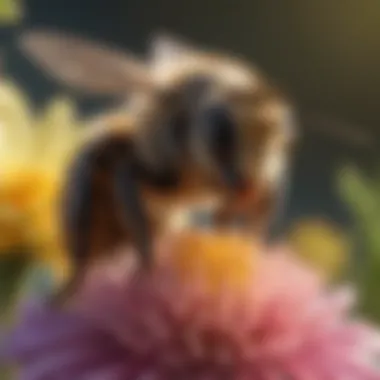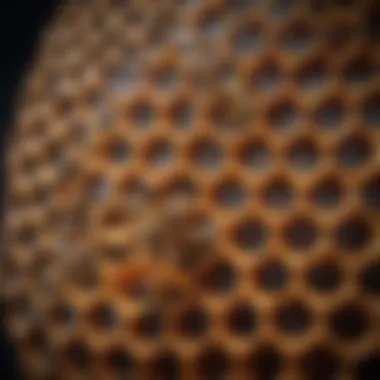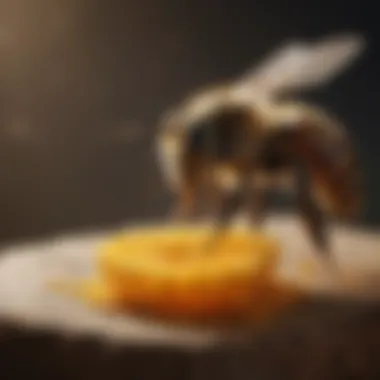Effective Strategies for Managing Bees in Your Home


Intro
Understanding the Pest
Identification
Identifying the type of bee you are dealing with is essential. Common types include honeybees, bumblebees, and wasps. Honeybees are generally smaller and have a more slender body covered in dense hair, while bumblebees are larger and have a rounder shape with a fuzzy appearance. Wasps tend to be more elongated with smooth bodies. Understanding these differences can help in determining the best approach for management.
Life Cycle
Bees usually have a specific life cycle, including the egg, larva, pupa, and adult stages. Understanding this cycle can aid in predicting their behaviors. For instance, during late spring and summer, colonies are often in their peak activity, foraging for food and reproducing. Awareness of their life cycle allows homeowners to anticipate them and act before they become a problem.
Pest Prevention Strategies
Environment Modification
Modifying the environment can greatly reduce the appeal for bees. This includes:
- Keeping food sources covered or stored properly.
- Sealing cracks and gaps in walls and foundations.
- Removing blooms and plants that attract bees from immediate vicinity of the home.
Creating a less hospitable environment reduces the chances of bee habitation.
Physical Barriers
Physical barriers can also deter bees from entering homes. Installing screens on windows and doors can provide a barrier without obstructing ventilation. Use caulking to seal openings around utility lines and other entrance points. Furthermore, bee traps can be set up in areas you want to keep clear of bees.
Control Methods
Chemical Control
If bees do become a problem, chemical control may be necessary. However, caution is paramount. Products containing pyrethroids are commonly used, but they can be harmful to beneficial insects and children. Always read the labels and follow instructions.
Biological Control
Biological control methods focus on managing the population through natural predators. Introducing certain predatory insects, like specific types of wasps that predate on bee larvae, can minimize their numbers without harmful chemicals. This approach is more environmentally friendly and sustainable.
It's important to note the legal implications of bee management, as many species are protected under law. Always consider humane removal options.
Understanding Bees and Their Role
Understanding bees and their role is essential when discussing strategies for managing their presence in your home. Bees are vital pollinators, impacting a range of ecosystems and agricultural systems. Their leading function in pollination contributes to the reproduction of flowering plants, enhancing biodiversity. Notably, many food crops rely on bees for their fertility, making their presence in the environment crucial for food security. Without understanding these benefits, one may overlook their ecological significance.
Types of Bees Commonly Found in Homes
Several types of bees may invade residential spaces. Honeybees are often the most recognized, known for their structured colonies and honey production. Bumblebees also might be found, typically nesting in grassy areas or old rodent burrows. Furthermore, carpenter bees can pose a nuisance as they bore holes into wood for nesting, which is often seen in structures like porches.
It's worth noting that different species exhibit distinct behaviors and nesting preferences. Understanding these variances aids in identifying the specific type of bee involved in an infestation, leading to more targeted management strategies.
Key species to consider include:


- Honeybees
- Bumblebees
- Carpenter bees
- Mason bees
In terms of identification, examining physical characteristics, such as size and coloration, is important. This can help differentiate between similar-looking species.
The Ecological Importance of Bees
The ecological importance of bees extends beyond mere pollination. They facilitate the growth of plants that provide food and shelter for other species, establishing a chain reaction within ecosystems. Their activities promote genetic diversity in plants, enabling healthier crop production.
Moreover, bees contribute substantially to the economy. The agricultural sector benefits significantly from their pollination services, resulting in increased yields for fruits, vegetables, and nuts. According to estimates, the economic value of bees to agriculture ranges in the billions of dollars, underscoring their necessity.
To preserve ecosystems, it is crucial to consider the wellbeing of bee populations.
Potential Hazards of Bee Encounters
While bees play an essential role in nature, encounters with them can lead to potential hazards. The most significant risk includes allergic reactions. For some individuals, bee stings may result in severe allergic responses, necessitating medical attention. Knowing the risks is especially important for those who may have previous allergies or reactions.
Another concern involves the psychological impact of bee presence. Many individuals experience anxiety or fear of bees, affecting how they interact with their outdoor spaces. Understanding bee behavior can reduce this anxiety, as knowledge about why bees visit certain areas can help individuals feel more in control.
Finally, structural issues can arise from certain bee species. For instance, carpenter bees can weaken wooden structures by boring holes, leading to increased maintenance costs. Recognizing the potential for damage can motivate proactive measures.
Assessing the Situation
Assessing the situation when bees are present in your home is crucial. Understanding the parameters of the bee encounter can significantly influence the approach taken for removal. Knowledge about the species, the extent of the infestation, and their behavioral patterns is vital. When one correctly assesses the situation, it helps in choosing the most effective strategy for managing bees, while also minimizing risks for humans and the bees. This process can save both time and potential danger.
Identifying the Species of Bee
To handle a bee situation effectively, identifying the species is the first step. Different bees have varying behaviors and levels of aggression. For instance, honeybees are generally less aggressive unless provoked, while wasps can be more territorial. Key identification features can include:
- Color and Size: Honeybees are typically orange-brown and slightly fuzzy, while yellow jackets are bright yellow with black markings.
- Nest Type: Honeybee hives are usually found in hollow trees or built structures, while wasps build paper-like nests in various locations.
- Behavioral Traits: Observing their behavior can also help. For example, wasps tend to be more visible during daytime scavenging for food.
Having accurate information on the bee species aids in determining an appropriate approach for removal, either humane or aggressive.
Determining the Size of the Infestation
The size of the infestation is another important factor in your assessment. Small groups of bees can often be dealt with differently than larger colonies. To gauge the size, consider:
- Number of Bees: Observe from a safe distance to estimate the number of bees entering and exiting.
- Nest Size: Check for the size of the nest, if visible. Larger nests indicate a more significant infestation.
- Location: The position of the nest plays a role. Nests in attics or walls may require professional intervention.
Understanding the size can inform if immediate action is needed or if it is safe to monitor the situation longer.
Behavioral Patterns of Bees
Understanding how bees behave is essential in developing a strategy to deal with them. Bees have specific patterns that can indicate their level of aggression and activity. Key points to consider include:
- Feeding Habits: Many bees are attracted to sugary substances. Leaving food out may draw them further into your living space.
- Time of Day: Bees are generally more active during warm daylight hours, which affects when to approach removal strategies.
- Nest Defense: Bees will defend their nest vigorously. Approaching a nest without assessing their mood can lead to stings.
By observing these behavioral traits, one can choose the right moment to attempt removal safely or defer to professionals.
Overall, a well-rounded assessment can help manage bee encounters effectively, enhancing safety for both the humans involved and the bees themselves.
When one is equipped with the right information, it ensures a measured and informed response.


Methods for Bee Removal
Dealing with bees in residential areas requires careful thought and planning, especially when it comes to their removal. The methods employed can affect both the safety of the individuals involved and the wellbeing of the bee population. Understanding the various approaches enables homeowners to make informed decisions that align with their values, emphasizing the need for responsible bee management.
Non-lethal Removal Techniques
Non-lethal techniques are often the most desirable first step when handling bees. These methods aim to relocate bees safely without causing harm. Here are several key strategies:
- Trap and Relocate: This involves capturing bees in a contained space, like a specially designed hive, and moving them to a safer location. It's important to contact local beekeepers who can assist in this process.
- Natural Repellents: Using natural substances known to deter bees can be effective. Essential oils, like peppermint or lemon grass, can be diluted and sprayed around areas where bees frequent. Ensure to apply these around entry points rather than directly targeting the bees, as direct confrontations can provoke aggression.
- Physical Barriers: Installing screens and proper sealing of entry points can prevent bees from entering your home. Maintaining clean surroundings and removing food sources will also discourage them from building nests nearby.
These non-lethal strategies can preserve the ecosystem while ensuring personal safety. They highlight a growing trend towards humane pest management practices that respect nature.
Lethal Removal: When It's Necessary
While non-lethal methods are preferable, there are circumstances when lethal removal becomes necessary, particularly when a hive poses an immediate threat. The following criteria should guide this choice:
- Aggressive Behavior: If bees exhibit overly aggressive behavior and pose a risk to people, professional intervention may be warranted.
- Health Risks: Individuals with bee sting allergies are at higher risk. In such cases, swift action may be required to eradicate the threat.
- Structural Damage: Large infestations can lead to structural damage in homes, making removal urgent.
In situations where lethal measures are considered, it's crucial to follow local regulations regarding pesticides and removal processes to minimize harm to surrounding wildlife.
Utilizing Professional Services
Engaging professional pest control services is often the best course of action when dealing with bee infestations. Professionals have the experience and resources to handle bee removal safely and effectively. Here are the benefits of hiring professionals:
- Expertise: Trained professionals can correctly identify bee species and choose appropriate removal strategies.
- Safety: Experts are equipped to handle aggressive situations and know how to protect themselves and residents from potential stings.
- Compliance: Professionals are familiar with local regulations regarding bee removal, ensuring compliance with conservation laws.
Choosing to work with professionals not only enhances safety but also ensures that removal occurs in a manner that respects the bees and the environment.
"Engaging professionals brings peace of mind, knowing that removal is handled safely and effectively."
In summary, the methods for bee removal range from non-lethal techniques that prioritize ecological balance to necessary lethal interventions and the engagement of professional services. Each option requires careful consideration, guided by the specific context of the bee encounter.
Legal and Ethical Considerations
Dealing with bees in residential areas raises significant legal and ethical issues. Understanding these dimensions is crucial for anyone who encounters bees in or around their home. Not only does this knowledge help in making informed decisions, but it also fosters a responsible attitude towards our environment.
Understanding Bee Conservation Laws
Bee conservation laws vary widely by region, reflecting the need to protect these vital pollinators. In many countries, certain bee species are protected under environmental legislation. For instance, the Endangered Species Act in the United States includes protections for specific types of bees. Homeowners should familiarize themselves with these laws to avoid legal repercussions when managing bee populations. Failing to comply with such regulations can result in fines and other penalties.
In addition, municipalities often have local ordinances regarding beekeeping and pest control, which can dictate how one should manage bees that invade private property. Understanding the relevant laws ensures that homeowners act within legal bounds while addressing bee encounters safely and effectively.
Ethics of Bee Management
Ethically managing pest encounters defines one's approach to resolving issues without unnecessary harm. Bees play a crucial role in ecosystems and agriculture as pollinators. Adopting a non-lethal strategy for their management can significantly contribute to local biodiversity and environmental health.
Homeowners are encouraged to consider humane solutions for bee management, such as relocation rather than extermination. It is essential to assess whether the bee presence poses a direct threat to household members or pets, as well as to evaluate the overall benefits these insects bring to the local ecosystem. By prioritizing ethical considerations, individuals can take responsible actions that align with eco-friendly practices.
Reporting Bee Sightings


If a homeowner identifies a bee species of concern, or if a large number of bees are present, reporting these sightings to local authorities or conservation organizations is advisable. This not only aids in accurate tracking of bee populations but also contributes to efforts to protect these insects.
Organizations often keep databases of bee sightings, helping researchers understand distribution patterns and population health. Reporting is particularly important for rare or endangered species. Homeowners can engage with community programs or local environmental groups, fostering a collaborative approach to bee preservation.
"Informed actions against bee-related issues contribute to better outcomes for both humans and bees".
Preventive Measures
Preventive measures are crucial in effectively managing bees in a home environment. By taking proactive steps, homeowners can significantly reduce the risk of bee infestations. This approach is beneficial for both human safety and bee conservation. Prevention can minimize confrontations with bees and ensure that their presence in the ecosystem is respected. Moreover, implementing these measures often results in less stress and fewer financial costs compared to dealing with an established infestation.
Identifying Entry Points
The first step in prevention is to identify potential entry points into your home. Bees can access properties through small openings, cracks, and gaps. Common areas to inspect include:
- Windows and Doors: Ensure that all windows and doors are tightly sealed. Check for gaps around frames.
- Vents and Chimneys: These are frequent entry points for bees. Installing screens can help minimize their access.
- Roof Eaves and Overhangs: Inspect these areas for cracks or openings where bees might nest.
- Utility Lines: Look for gaps around where utility lines enter the house. Sealing these gaps can reduce entry.
Regular inspections can help in identifying and sealing these openings before bees can establish a presence.
Maintaining Your Property
Property maintenance plays a significant role in bee prevention. A well-maintained home is less attractive to bees. Consider the following steps:
- Keep the Yard Clean: Regularly dispose of debris, old fruit, and food waste that can attract bees.
- Control Flowering Plants: While flowers are beneficial for bees, excessive flowering plants near the home can lead to increased bee activity.
- Secure Garbage Bins: Having tightly closed garbage bins can cut off food sources for bees.
- Regular Home Repairs: Fixing broken window screens, repairing roof leaks, and patching up any holes can go a long way in maintaining your property’s defenses.
A clean and well-maintained property will not only prevent bees but also enhance overall home appearance and value.
Natural Repellents and Barriers
Utilizing natural repellents and creating barriers can deter bees effectively without harming them. Here are several options:
- Essential Oils: Bees are often repelled by certain scents such as peppermint, eucalyptus, and citronella. Consider using these oils in diffusers or sprays around entry points.
- Cinnamon and Garlic: Spraying a mixture of cinnamon or garlic may deter bees from nesting.
- Physical Barriers: Garden netting can be an effective temporary solution to keep bees away from areas where their presence is unwelcome.
Implementing these natural solutions can create a peaceful coexistence with bees while still protecting your home from potential infestations.
Maintaining preventive measures is essential in dealing with bees. Thoughtful actions can lead to a harmonious environment where both homeowners and bees can thrive.
Epilogue
In addressing the complexities of bee management within the home environment, it becomes evident that sustainable practices and ongoing education play a pivotal role. The approach to dealing with bees is not trivial; it reflects a broader commitment to ecological health, community safety, and personal well-being.
Sustainable Practices for Bee Management
Sustainable practices in bee management are essential in ensuring both human safety and the wellbeing of bee populations. Implementing these methods can mitigate infestations without resorting to harmful measures. Here are some key practices to consider:
- Habitat Preservation: Protecting natural habitats encourages a balance between bee populations and humans. It allows bees to thrive while reducing conflicts with human dwellings.
- Native Plant Cultivation: Planting native flowering plants can effectively attract bees away from homes. These plants provide food sources for bees, helping to sustain their populations and decrease their nesting near residences.
- Bee-attractive Landscaping: Design your garden in a way that naturally attracts bees, without drawing them too close to your home, by planning physical barriers or using landscape features that deter nesting.
- Minimal Chemical Use: Avoid the use of harmful pesticides. These chemicals can create a detrimental impact on bee colonies and other wildlife.
- Informed Removal: When removal is necessary, consider non-lethal methods or engage local professionals who can ensure that removal is conducted humanely.
Adopting these sustainable strategies not only contributes to bee conservation but also fosters a healthy environment for everyone.
Continued Education on Bee Behavior
Understanding bee behavior is crucial for safe and effective management. Continued education enforces a knowledge base that benefits homeowners and pest control professionals alike. Recognizing different bee species helps in distinguishing which are harmless and which might pose a threat. Education includes:
- Workshops and Community Programs: Attend or organize local workshops focusing on bee identification and ecological roles. These offer practical knowledge and create a community of informed citizens.
- Social Media Platforms and Online Forums: Engaging with platforms such as Facebook or Reddit can provide real-time discussions among enthusiasts and experts about bee behavior and management strategies. Participating in these conversations keeps you updated.
- Reading Material: Seek out literature on bees, their life cycles, and their behavioral patterns. Websites like en.wikipedia.org and britannica.com provides curated resources that can enhance your understanding.
Ongoing education develops a foundational awareness that not only aids in immediate encounters with bees but also promotes a culture of respecting and protecting these valuable creatures.
"To understand the creatures we share our space with fosters a culture of respect and coexistence."







